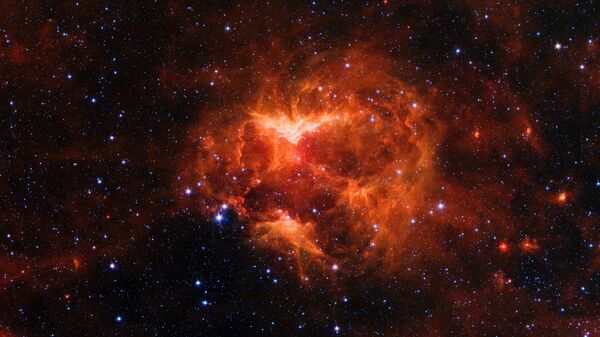Space is often thought of as a cold, dead void with no atmosphere where everything either floats motionless or moves so fast that we won’t know about it until it takes us out. Recent astronomical observations, however, now offer proof that cosmic mechanics can cause galactic winds that span billions of light years.
Research published in the Natural Astronomy journal details observations of a distant galaxy called SDSS J211824.06+001729.4, nicknamed Makani after the Hawaiian word for ‘wind,’ made using the Keck Cosmic Web Imager. Makani is actually not one, but two galaxies which collided billions of years ago.
When galaxies collide, enormous amounts of gas become compress, leading to the creation of massive new stars – a phenomenon known as a ‘starburst.’ The collision itself, the star formation and exploding supernovas, create massive outbursts of hot ionized gas, notes astrophysicist Alison Coil of UC San Diego.
Our paper on "Makani" (wind in Native Hawaiian) has come out in Nature. https://t.co/kU3T7MoAwX. In this paper we discuss the huge wind being blown into the circumgalactic medium around a merging star-forming galaxy. pic.twitter.com/MZK9yZReZR
— Prof. Gregory Rudnick (@gregrudnick) October 31, 2019
And by ‘massive,’ they mean 4,900 square kiloparsecs, or roughly 52-billion square light-years. That is a lot of gas.
What makes it more remarkable is that the ionized gas is very hot oxygen, astronomers assert, adding that gas temperatures can reach up to 10,000 degrees Kelvin (about 9726.85 degrees Celsius or 9726.85 degrees Fahrenheit).
A. Coil showing results for J2118+0017 / Makani galaxy, 100 kpc limb-brightened bipolar outflow. Here’s the SDSS link: https://t.co/zeaw403M1k
— Aleks Diamond-Stanic (@adiamondstanic) September 20, 2019
#GMT19 pic.twitter.com/V7FEawnnQv
There are two ongoing outbursts in Makani, which astronomers believe formed at different times. Shaped like hourglasses, the two energy sources are expanding into space at a whopping 1,400 kilometres per second and 2,100 kilometres per second each.
"The earlier outflow has flowed to large distances from the galaxy, while the fast, recent outflow has not had time to do so," said physicist David Rupke of Rhodes College.
According to Rupke, the two outbursts suck in galactic matter as they move through space, and currently have captured huge amounts.
"And it's moving a lot of it - at least one to 10 percent of the visible mass of the entire galaxy - at very high speeds, thousands of kilometres per second."
Astronomers say this is one of the first insights into the formation process of a so-called circumgalactic medium around a massive galaxy.

